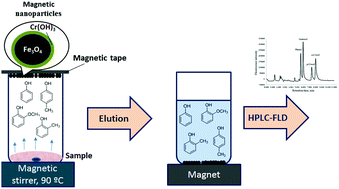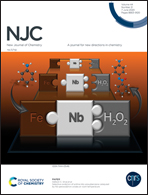Magnetic headspace adsorptive microextraction using Fe3O4@Cr(OH)3 nanoparticles for effective determination of volatile phenols†
Abstract
In this study Fe3O4@hydroxide and Fe3O4@oxide nanoparticles were investigated for the magnetic headspace adsorptive microextraction for the first time. Fe3O4-based composite magnetic nanoparticles were used for adsorption of volatile phenols as model analytes from baby food samples. The effect of nanoparticle composition on adsorption behaviors of phenols was studied. The results showed that the synthesized Fe3O4@Cr(OH)3 nanoparticles provided the most effective headspace adsorptive microextraction of phenols. A novel sample preparation procedure for the determination of phenols in food samples by high performance liquid chromatography with fluorescence detection was developed. A linear calibration range of 0.5–2500 μg kg−1 was obtained with correlation coefficients in the range of 0.996–0.998. The LOD, calculated from a blank test, based on 3σ, was 0.2 μg kg−1. The repeatability of the proposed method was evaluated at 0.5 and 2000 μg kg−1 spiking levels, and the coefficients of variation ranged between 1 and 8% (n = 4). The developed procedure provided phenol separation from samples with recovery from 90 to 118%.



 Please wait while we load your content...
Please wait while we load your content...